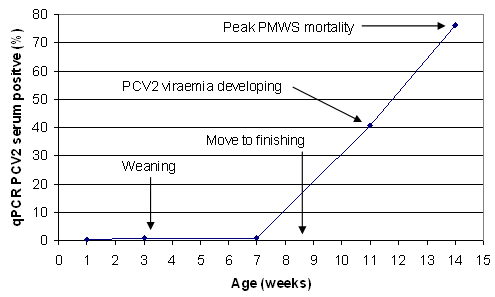In a recent paper, Grau-Roma and others (2008), from the Autonomous University of Barcelona, reported on the infection dynamics of porcine circovirus type 2 (PCV2) in 6 batches of pigs in Spain from 3 farms, which were either two or 3-site production systems. Weaning was at 3 weeks of age and movement from the nurseries to the finishing site was about 8-9 weeks of age. Blood was taken at regular intervals (see Figure 1) and tested for virus DNA by a quantitative PCR technique.

The Spanish findings were similar to my own when I was involved with a farming group, which operated a 3-site all-in all-out production system. We could have mortality as low as one percent in the nurseries, but the PCV2 viraemic surge and consequent mortality (approximately 9%) and chronic wasting (also 9%) occurred in the finisher sheds at about 11-16 weeks of age. This seems to be the finding consistently in many of the US and Canadian field trials, where the main chronic mortality was associated with the finishing pig rather than the nursery and presumably when maternal antibodies are waning and the pigs become susceptible to a challenge.
Sows were also tested for PCV2 viraemia by qPCR. Only 2.3% were viraemic and this contrasted with 39.3% of sows in Danish 1-site herds. Although it is known that there is vertical transmission of PCV2 from sows to piglets, it also raises the question how much spread or reinfection takes place within a single site production, where there is also active excretion and contamination going on from challenged and susceptible, growing pigs. Breed, climate and other diseases may have an impact but I suspect the production system also is important.



